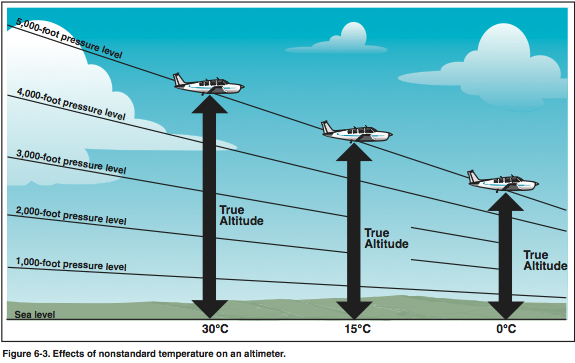Altimeter Reading at Non-standard Temp and Pressure
There are lots of questions on the FAA Knowledge Tests about altimeter readings at non-standard temperature and pressure settings. The non-standard pressure questions are fairly intuitive. We all know that pressure decreases as altitude increases. Therefore, if the pressure is lower than what the altimeter expects, the altimeter is fooled into thinking it is higher than it actually is. Likewise, if the pressure is higher than standard, the altimeter reads lower than it should.
Dramatic and dangerous effects most commonly occur when crossing a frontal boundary from an area of high pressure to an area of low pressure. If the altimeter is set to the local altimeter setting in the area of high pressure and the aircraft flies to an area of low pressure, without changing the altimeter setting, the altimeter reading will be too high, possibly by hundreds of feet. Less dramatic changes happen all the time when you fly. As an example, right now the altimeter setting at KSBP is 30.08. The setting at KSBA (62 nm away) is 30.01. If you fly to KSBA you would notice a change in altitude of -70 feet when you get the new altimeter setting from approach control. The aircraft is 70 feet lower than you thought. That is the origin of the memory aid, “HIGH TO LOW LOOK OUT BELOW”.
AIM 7−2−3. Altimeter Errors
b. Once in flight, it is very important to obtain frequently current altimeter settings en route. If you do not reset your altimeter when flying from an area of high pressure into an area of low pressure, your aircraft will be closer to the surface than your altimeter indicates. An inch error in the altimeter setting equals 1,000 feet of altitude. To quote an old saying: “GOING FROM A HIGH TO A LOW, LOOK OUT BELOW.”
Instrument Procedures Handbook
When cruising below 18,000 feet MSL, the altimeter must be adjusted to the current setting, as reported by a station within 100 NM of your position. In areas where weather-reporting stations are more than 100 NM from the route, the altimeter setting of a station that is closest may be used.
You will notice that, when using flight following or flying IFR, after checking in with a new controller, the controller will usually respond to your check-in with the altimeter setting he is using for flights in your area.
Non-standard Temperature
The same thing happens with temperature changes but it is less intuitive because we don’t have day-to-day experience with changing the altimeter with variations in temperature. We also learned about combustion in the engine and associate high temperatures with high pressures and that can lead to us getting tangled up in our thought process. Lets start from scratch and build a mental model of how the altimeter works.
Think of the aircraft as siting in a column of air. The altimeter measures the weight of the air above the aircraft. It doesn’t really know how much air is below it or how high it is above the ground. It just knows that at a certain pressure from the air above it makes it read a specified height. It has been calibrated for standard temperature and pressure lapse rates. If the temperature or pressure don’t change as expected, the weight of the air above it will not be the same as it is calibrated for, and it will give erroneous readings.
Let’s start our thought experiment with temperature and pressure at standard (29.92″ and 15°C) and the aircraft at 5,000′ MSL and AGL. Now imagine that the entire air mass being heated to be warmer than standard temperature. We know from high school physics that air expands as the temperature goes up. The entire column of air now expands and as the column of air expands, the aircraft moves higher in the column. Note that the weight of the air above the aircraft hasn’t changed, it just takes up more room. Since the weight of the air hasn’t changed, the altimeter reading hasn’t changed. The aircraft is now at a higher AGL than it was before but the altimeter still says 5,000′ MSL.

The reverse occurs when air temperature is lower than standard. As shown on the graphic above, the altimeter will read lower than it should if the air temperature is colder than standard. The same memory aid we used with pressure applies, “HIGH TO LOW LOOK OUT BELOW”.
People often get the impact backwards when they try to relate it to knowledge of engine combustion. In an engine, higher temperatures indicate higher pressures. So they think that if the temperature is higher, then pressure is higher. Normally higher pressure means altimeter reading is lower. The reason higher temperatures equate to higher pressures in an engine cylinder is because of the ideal gas law PV= nRT. For a fixed volume, higher temperature means higher pressure. But the volume is not fixed in the atmosphere, so the reasoning doesn’t translate directly to this problem.
For those who care, the standard corrections for temperature are: For each 10° C the OAT is warmer than ISA increase the indicated altitude by 4% to give true altitude. For each 10° C the OAT is cooler than ISA decrease the indicated altitude by 4%.


